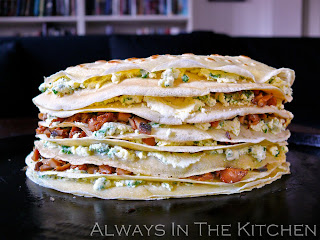
Chili and cornbread is a really classic combination. Cornbread, of course, can take many different shapes and forms, not to mention bonus flavours and the eternal debate between sweet/not-sweet that rages through the Americas. My favourite, growing up, was Southern Spoon Bread, a cornbread leavened with beaten egg whites into a lusciously light accompaniment to almost any meal. But I like all kinds of breads made from corn.
Stew Dumplings are the fastest form of bread that I know. They're quicker to whip up than cornbread, biscuits, or scones. The dough requires no resting period like tortillas or arepas, and because they cook on the stovetop, right on top of whatever savoury concoction you're already simmering, they take very little time to cook. No oven pre-heating, no extra pan(s) to grease. I like Stew Dumplings for beef or chicken stew, but chili feels like it needs a little extra something. So, after looking at my cornbread recipe, I decided to simply swap out some of the all-purpose flour with yellow cornmeal in my classic Stew Dumplings recipe. It worked wonderfully, and the next time I do this I may also add some chile flakes, to make them prettier.
While I used these on top of a simple ground beef and bean chili, I think you could also use them on a chicken stew with great success, especially a green chile chicken stew.
Cornmeal Dumplings
Makes 8 dumplings
(serves 4)
Total Prep & Cooking Time: 20 minutes
2/3 cup all-purpose flour
1/3 cup yellow cornmeal (not superfine)
2 teaspoons baking powder
Pinch chile flakes (optional)
1/2 teaspoon kosher salt
1-2 tablespoons chicken fat or canola oil
1/2 cup 1% milk
In a medium mixing bowl, use a fork to stir together the flour, cornmeal, baking powder, and salt. Add the chicken fat (or canola oil), and stir it through – it will give the flour a lumpy appearance, which is fine – keep stirring until the lumps are very small. Add the chile flakes, if using, and stir through.
Make a well in the middle of the flour mixture, and pour the milk in all at once. Stir (with a fork) very rapidly and thoroughly, until all of the dry flour is brought into a stiff, sticky, batter. Use a tablespoon to drop eight (8) dollops of batter evenly over the surface of a bubbling, hot stew. Make sure there is sufficient liquid in the stew – the dumplings should just have their “feet” wet, but mostly be sitting on top of solid lumps. If there is too much liquid, the dumplings will sink a bit. They'll still taste good, but will expand downward instead of upward, and be a bit denser and wetter.
Cover the pot tightly, set the burner temperature to low (so the chilli doesn’t burn) and let the dumplings cook for 15 minutes – no peeking! Do not lift the lid until the dumplings are cooked, or they will become dense and soggy. Serve two dumplings per person.
If you're one of those really organized pantry people, you might want to jar-or-bag up premixed dry ingredients, since you only then need to add a dollop of fat and the milk (you could also use milk powder in a mix, for truly hardcore, and just add water and oil).
For classic Stew Dumplings, replace the cornmeal with more all-purpose flour, and add 1/4 cup chopped fresh parsley.






































